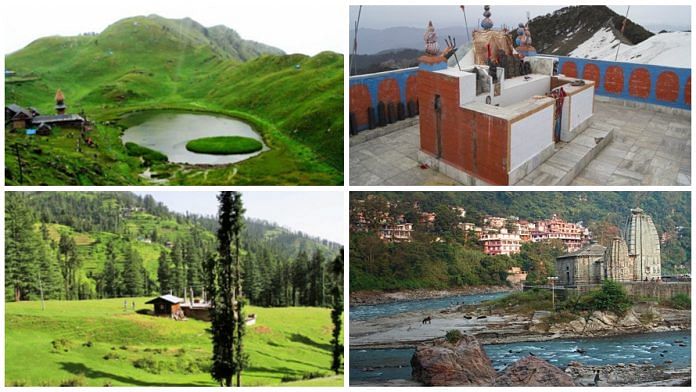New Delhi: On 14 December, Prime Minister Narendra Modi inaugurated the Rs 700 crore Kashi Vishwanath Corridor in his constituency Varanasi (also known as Kashi). The PM took a dip in the Ganga, before carrying holy water from the river to the Kashi Vishwanath temple, and offering prayers there. In the evening, he saw the Ganga aarti from a boat.
Approximately two weeks later, the Prime Minister, on a visit to the town of Mandi in Himachal Pradesh Monday, said he was blessed to be in “Chhoti Kashi”. The PM was there to inaugurate and lay the foundation stone for hydropower projects worth over Rs 11,000 crore.
Both UP and Himachal are scheduled to vote for the assembly in 2022, the latter in the later part of the year.
Addressing the crowd in Mandi in the local dialect, Mandyali, Modi expressed his happiness at being in “Chhoti Kashi after visiting Kashi Vishwanath the same month”.
He also mentioned his visits to the town’s Bhootnath temple and Panchvaktra temple, and spoke about the ongoing work for the Shiv Dham project there, for which he had laid the foundation stone in February.
Modi’s reference to Mandi as “Chhoti Kashi” was reiterated by Himachal Pradesh CM Jai Ram Thakur, who said the moniker could be traced to the fact that Mandi has “300 temples” and that the state government was trying to develop it on the same lines as Kashi.
Also read: ‘I accept responsibility for bypoll defeats, they’re an eye-opener for BJP’: Himachal CM Thakur
What gives Mandi the moniker of ‘Chhoti Kashi’
Situated on the banks of the river Beas, the town of Mandi dates back to 1527 AD, when a king named Ajbar Sen built his palace here. It became a part of Himachal Pradesh, when it was created as the Chief Commissioner’s Province in 1948.
The town is known for its many ancient stone temples and the week-long Shivratri festival, celebrated in February-March every year. The date varies according to the Hindu calendar.
Many of its temples have been declared “protected” monuments by the Archaeological Survey of India, because of their heritage value. The Panchvaktra Temple, Trilokinath Temple, Ardhnarishwar Temple and Barsela Monuments in Mandi are included in the list of monuments of national importance.
“Mandi has many temples, and all kinds of them. Some dedicated to Shiva, some to Shakti and some that are Vaishnav temples. But if you look at numbers, those dedicated to Shiva outnumber the rest. It is this which gives Mandi the popular name of ‘Chhoti Kashi’, said B.M. Pande, former ASI director and author of the book Monumental Heritage of Mandi.
ThePrint lists a few popular ones in town.
Bhootnath Temple: Believed to have been constructed by Raja Ajbar Sen back in 1527 AD, the temple is dedicated to Lord Shiva and is situated right in the centre of the town.
Panchvaktra Temple: This temple is located at the confluence of the Beas and the Suketi rivers. The deity here is a five-headed Shiva (panch is five), with the five faces depicting his different moods. The stone-sculpted temple has carvings of divine figures and writings on its surface. When exactly the temple was built remains a bit of a mystery, but it was restored under the reign of King Sidh Sen (1684-1727), after being damaged due to floods.
Ardhnarishwar Temple: The temple has Ardhanarishwar — a form half-man-half-woman, or the union of Shiva and Shakti — as its main deity. The temple is situated right in the heart of the town.
Trilokinath Temple: Dedicated to the three-headed Shiva, representing the deity that rules the three planes of Earth, Heaven and Hell, the stone temple includes a main shrine (or garbagriha) and a hut-like structure placed right before it. The temple is believed to have been built by Ajbar Sen’s wife.
Shikari Devi Temple: The temple is situated at the highest peak of the district, at a height of 3,359 metres, and is popularly known as the “crown of Mandi“. The roofless temple is dedicated to a local goddess. It is said to have been built by the Pandavas.
Tarna Devi Hill: Built of red and white stones, this 17th-century temple is dedicated to Goddess Kali. The idol has three faces. According to popular belief, the temple was constructed by local ruler Raja Shyam Sen, who was a devotee of the Goddess.
Madho Rai Temple: Known as the protector of Mandi, Madho Rai is another name for Lord Vishnu. The temple is believed to have been constructed by Raja Suraj Sen of Mandi. The king did not have an heir and thus a silver image of Radha and Lord Krishna was named Madho Rai and ordained as the king of Mandi after Suraj Sen’s death.
The town’s Shivratri fair is mainly centred around the two temples of Madho Rai and Bhootnath.
The town also has lakes, such as Prashar and Kamrunag, which are popularly believed to holy. While Prashar lake is named after the sage Parashar, Kamrunag is a name for King Yaksha of Mahabharata, who was worshiped by the Pandavas. He is also known as the “God of rains”. Both lakes also have temples attached.
(Edited by Poulomi Banerjee)
Also read: Sympathy for Virbhadra widow, inflation caused bypoll defeat: Himachal BJP chief Suresh Kashyap






